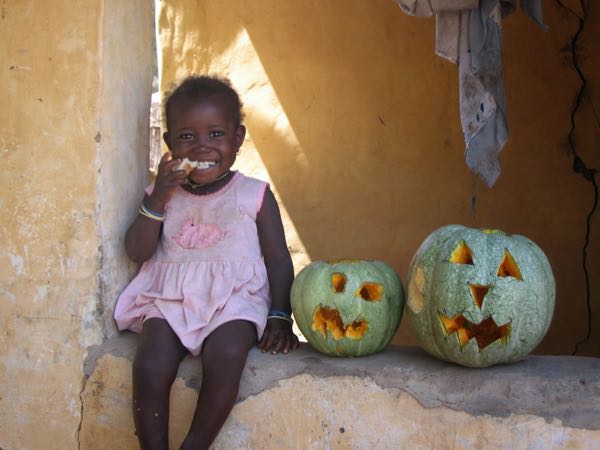
On pumpkins, wastefulness, and abundance
I think of pumpkins and can’t help but think of her. She was just a toddler when I met her, close to the age of my daughter now. I still see her mischievous smile, her face sprinkled with dirt and dust, her hands reaching towards me.
Her name is Mariama.
It was my given African name, too, and in The Gambian culture that afforded you a special relationship. She wasn’t named after me, but her family, nevertheless, granted me that precious status.
I watched her grow during my two years living in her village. I laughed with her. I fell asleep with her on the concrete slab in the compound. I carried her on my back. I ate from the same food bowl as her. She trusted me and I adored her. She taught me not to worry about getting my clothes dirty, to open my hands to one and all, and to smile with reckless abandon.
When Halloween came my first October in village I couldn’t pass up the opportunity to share my joy of pumpkin carving. From the thrill of picking a pumpkin in the field, to feeling the gooeyness of the inside, to designing the perfect face to carve, I loved the season of pumpkins. Pumpkins were a part of the harvest in my village and were a treat in any rice or cous dish. But my family knew nothing of designing a face on the pumpkins and carving them.
With the kids of the compound we found our pumpkins and made our designs. We got our hands dirty and wet, we laughed together, we made scary and funny faces, we cut out designs on the pumpkins. The same concrete slab where we spent our evenings eating and falling asleep under the stars became our canvas for creativity and exploring our pumpkins.
Mariama was there too smiling and laughing with us.
When everyone finished carving and was content with their new creations we lit candles and placed them in the pumpkins. The night was alive not only from the moon and the stars this night, but from our delightful creations.
We looked proudly on what stared back at us. For a few moments we stood in awe.
Then Mariama’s mother asked me, "What do we do with them?"
"We just look at them," I say.
"That's it?" She looks back quizzically with a hint of concern. "We need to eat them. We can't have them go to waste."
And there in that moment, in my attempts at sharing across the cultures and bringing Halloween to The Gambia, I was face-to-face with my own culture's excessiveness. What for me was an act of fun, memory-making, and remembering was actually an act of wastefulness.
I thought of all the pumpkins I had carved over the years. And I thought about what happened to them after Halloween. The fact that I couldn’t remember what I did with them convicted me and haunted me in that moment. I carved pumpkins for fun. For joy. For tradition. And because it was always done that way. Until that moment and that question about what the pumpkins were for, I hadn’t thought about what should be done with them other than carving.
I hadn’t thought that so many would relish the taste of pumpkin in their meals.
The pumpkins were so much more to The Gambians. They provided so much more for them.
And I felt ashamed.
I felt my privilege of growing up oblivious to all that I wasted on a daily basis. I wondered what else I had used and misused and tossed aside.
I took a picture of Mariama smiling by the pumpkins. Her face full of life. Alive to that moment smiling to the camera for this American girl who had so much to learn. I look at that picture often, especially around Halloween and I think about what she’s doing now and how she’s grown. I think about where I am now and how much I’ve grown too. But I wonder if I’ve really learned those lessons that were taught to me - if I’m less prone to waste and more adept at living simply.
I look around my house and wonder how many of my things could face the same question I received about the pumpkins: “What do you do with them?”
And too often I feel overwhelmed by what I have and ashamed.
What do I do with much of my belongings? Have them sit on shelves or in closets? Have them go unused for months so I forget about them? Have them collect dust? Have them just in case I’ll need them at some later time?
“What do you do with them?”
Too often I don’t even look at all I have.
This fall we have our pumpkin on the front porch. I plan to carve it with my daughter and son. I also intend to tell them about Mariama. About this girl who taught me about simplicity and abundance, about this girl just like them, but so very far away from them, too. We’ll compost our pumpkin and I’ll tell them that in composting our pumpkin it’ll be turned into soil and will help us grow our garden next year. We won’t just throw it away, but will let it be turned into something new.
On that Halloween in The Gambia after the pumpkins were carved and lit, we placed them on the front porch and basked in their glow. We were proud of our carvings.
And the next night we feasted on pumpkin.